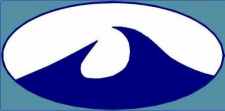Keith Mackie
Consulting Coastal and Harbour Engineer
Dry Docks
Dry docks have always been the “Cinderella” of harbour engineering. No one seems to take much notice of them. I have made them my particular speciality and tried to develop a coherent approach to the subject. In particular I have set out to develop a theory of dry docking. Slipways are a particularly neglected style of dry docking – a direct result of the lack of a coherent design theory.
One can usually tell, just by looking at a dry docking facility, which parts have been designed by a civil engineer, which by a naval architect. Neither, unless they specialise in dry docking — which is rare — have any feel for the subject.
The various types of dry docks are
- GRAVING DOCKS
- FLOATING DOCKS
- SHIPLIFTS
- SLIPWAYS
- TRANSFER SYSTEMS
- SMALL CRAFT LAUNCHING RAMPS
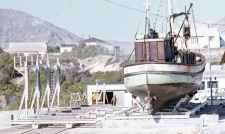 The slipway, a cradle on wheels on rails running down into the sea, was patented in 1819 in Scotland by Thomas Morton. The original form was pretty primitive and here at the Cape, in South Africa, developed a particular form of their own. My involvement in this field started with these simple “Cape” type slipways.
The slipway, a cradle on wheels on rails running down into the sea, was patented in 1819 in Scotland by Thomas Morton. The original form was pretty primitive and here at the Cape, in South Africa, developed a particular form of their own. My involvement in this field started with these simple “Cape” type slipways.
This is my first slipway, a basic “Cape” system in the fishing harbour of Gansbaai to which I added a docking frame and hydraulic bilge support arms operated by handpump from the catwalk on the docking frame. It has a separate side slip cradle riding “piggy–back” on the main cradle.
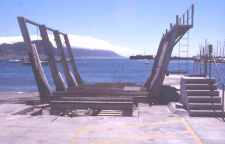 My next slipway was built for the South African Navy in Simonstown for their small craft and yachts. This one doesn't have hydraulic bilge arms — that would have been a bit too much for the Navy to swallow in one gulp. The inovation in this one was the construction of the ways. They are set to a verical circular curve — the first in Africa. The ways structure was constructed in steel in the Naval Dry Dock, floated out and set onto precast concrete pedestals and clamped to these by removable clamps. These in turn had been set in place to very accurate levels by framed jigs that located each pair accurately in alignment from the previous pair and ensured that the prefabricated ways fitted the pedestals.
My next slipway was built for the South African Navy in Simonstown for their small craft and yachts. This one doesn't have hydraulic bilge arms — that would have been a bit too much for the Navy to swallow in one gulp. The inovation in this one was the construction of the ways. They are set to a verical circular curve — the first in Africa. The ways structure was constructed in steel in the Naval Dry Dock, floated out and set onto precast concrete pedestals and clamped to these by removable clamps. These in turn had been set in place to very accurate levels by framed jigs that located each pair accurately in alignment from the previous pair and ensured that the prefabricated ways fitted the pedestals.
The slipway in the fishing harbour of Lamberts Bay embodied all the technical innovations I had developed over the previous 15 years. It was designed in accordance with Lloyds Register Rules for Lifting Appliances in a Marine Environment and checked and certified by them — the first in Africa to get this certification. It was for the design and construction of this facility that I was awarded the South African Institution of Civil Engineers Basil Read Gold Medal for Construction.
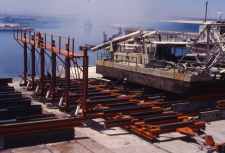
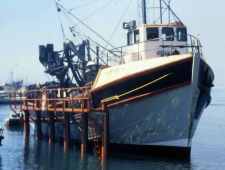
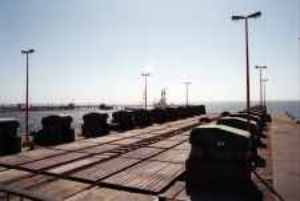 I built the 2000 ton lift Syncrolift© shiplift at Walvis Bay in 1972 and supervised the management of it and the technical services until 1991. It was during this period that I developed the rope maintenance procedures reported in my paper “Corrosion in Mechanical Dry Docking Systems” (see TECHNICAL PAPERS).
I built the 2000 ton lift Syncrolift© shiplift at Walvis Bay in 1972 and supervised the management of it and the technical services until 1991. It was during this period that I developed the rope maintenance procedures reported in my paper “Corrosion in Mechanical Dry Docking Systems” (see TECHNICAL PAPERS).
On two occassions I have had to salvage shiplifts, this one and the South African Navy shiplift in Durban.
I have also been involved in prefeasibility and feasibility studies, on behalf of the Namibian Port Authorities, for increases dry docking facilities in Walvis Bay leading to the provision of an 8000 ton lift floating dock in the port.
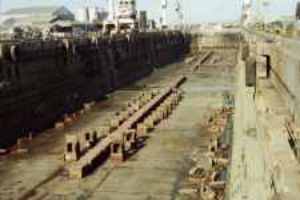 Recently, the South African National Port Authority asked me to take over the running of their dry docking facilities during a management crisis. The picture shows the 370m Sturrock dock during this period with blocks set for two ships. The aft set has high bilge blocks cribbed for stability in way of the stern cut–up.
Recently, the South African National Port Authority asked me to take over the running of their dry docking facilities during a management crisis. The picture shows the 370m Sturrock dock during this period with blocks set for two ships. The aft set has high bilge blocks cribbed for stability in way of the stern cut–up.
In the course my career I have had something to do with all types of dry dock spread across the whole spectrum activities.
As a result I am able of offer assistance in all aspects of dry docking.
- MARKET SURVEYS
- DRY DOCK FEASIBILITY STUDIES
- DRY DOCK DESIGN
- PROJECT MANAGEMENT OF CONSTRUCTION TO COMPLETION
- DRY DOCK SURVEYS
- DRY DOCK RATING
- SYSTEM UPGRADING
- DOCKING STAFF TRAINING
- ADVICE ON DIFFICULT DOCKING
- FORENSIC ANALYSIS OF AND REPORTING ON DRY DOCK ACCIDENTS
- SALVAGE OF DRY DOCK SYSTEMS AFTER AN ACCIDENT
- DRY DOCK MANAGEMENT
- DRY DOCK MAINTENANCE
By and large, a deep understanding of the interaction of ship and dock is needed to design economic, robust and efficient dry docking facilities.
A dry dock must also be designed to enhance the efficiency of ship repair activities, of the maintenance and painting work done on the ships using the dock. It is not sufficientmerely to remove the ship from the water.
This site is dedicated to the work of Keith Mackie, Consulting Coastal & Harbour Engineer. His particular speciality is dry docking in all forms, boat ramps, slipways, shiplifts,Syncrolifts© and floating and graving docks. He has written textbooks on Coastal & Harbour Engineering and on the Practice of Dry Docking Ships and gives training courses in these subjects.
